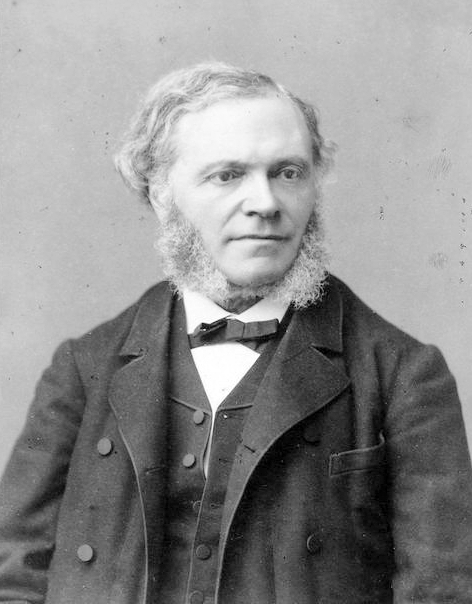Salomon Sulzer: Psalm 111
Considered the “father” of modern synagogue music, Cantor Salomon Sulzer created music that reflects the changes generated by the Jewish Emancipation. Beginning in the late 18th century, several countries in Europe eliminated a wide range of discriminatory laws, which opened some doors to allow Jews to participate in society. While before, most Jews were isolated in restricted areas away from the rest of society, they were now able to achieve integration and a broader education. Although Jewish communities wrestled with the degree of integration in all areas of their lives, one of several developments was the emergence of Reform Judaism, which brought modern European aesthetics into the synagogue service. As chief cantor of the new Seitenstettengasse synagogue, the Reform temple in Vienna, Sulzer took a key role in the “renovation” of synagogue music by using his command of European art music to create a musical service that respected Jewish musical tradition while at the same time incorporated the style of the early Romantic Viennese school, with the choir occupying a major role. His rendition of Psalm 111 reflects his musical ideals.
Composed for a festive occasion honoring the wealthy landowners of Sulzer’s temple, Psalm 111 was one of hundreds of works that Sulzer wrote for himself and his choir. The text, translated from Hebrew into English for tonight’s performance, praises God for His faithfulness and enduring righteousness. The original scoring called for tenor solo – sung by Sulzer himself – a choir of boys and adult men – women were not allowed in a liturgical choir – and organ and harp. Sulzer sets the first eight of the ten verses of text. After a lush introduction played by the organ and harp, the choir enters with repeated “Hallelujahs.” To bring contrast to the many reiterations, the choir sometimes sings in imitation and other times together in a variety of dynamics. Sulzer then presents verses 1 to 3 of the psalm in responsorial format, a style used for the singing of psalms since Biblical times. The soloist sings the first half of each verse while the whole choir responds with the second half. After a beautiful interlude played by the harp and organ, Sulzer changes his approach for verses 4 and 5, which are sung by the whole chorus emphasizing the words “Worship the Lord for all His wonders” and “God grants the righteous their due.” The tenor solo returns with a purposeful melody for verses 6 and 8, while the choir sings verse 7. Before the closing “Hallelujah” statements, Sulzer has the full chorus sing “We shall sing His praise evermore,” words that he added himself to emphasize the message of the piece. The conclusion mirrors the opening section, framing the piece with joyful reiterations of the word “Hallelujah.”
Leonard Bernstein: Chichester Psalms
Chichester Psalms is a choral composition in three movements for boy soprano or countertenor solo, choir, and reduced orchestra, although to make it more accessible to different instrumental groups, Bernstein also made a version for an even smaller ensemble of organ, harp, and percussion, which is used for tonight’s performance. The piece was commissioned in 1963 by Reverend Walter Hussey, Dean of Chichester Cathedral, Sussex, to be performed at the 1965 Southern Cathedrals Festival. Held every summer since 1960, the festival is a celebration of sacred music with the participation of the combined choirs of Chichester, Salisbury, and Winchester Cathedrals. Because the festival took place at Chichester that year, Dean Hussey was festival director and asked Bernstein to write a setting of Psalm 2, or some part of it, either unaccompanied or accompanied by orchestra or organ, or both.
Bernstein not only set to music Psalm 2, but wrote a “suite of Psalms, or selected verses from Psalms,” under the title, Psalms of Youth, a title he later changed as he felt it suggested that the piece was easy to perform. Unlike a good portion of the works he composed in 1965, when he was on sabbatical from his job as Music Director of the New York Philharmonic, Chichester Psalms is firmly rooted in tonality. Bernstein commented during a 1977 press conference, “I spent almost the whole year writing 12-tone music and even more experimental stuff. I was happy that all these new sounds were coming out. But after about six months of work, I threw it all away. It just wasn’t my music; it wasn’t honest. The end result was the Chichester Psalms which is the most accessible, B-flat majorish tonal piece I’ve ever written.” Bernstein dedicated it to Cyril Solomon, a British physician who served as liaison between himself and Dean Hussey.
The work was first performed at the Philharmonic Hall in New York City on July 15, 1965, with Bernstein conducting the New York Philharmonic with a mixed chorus and a boy alto, as he had obtained permission to give it a “try-out.” The official performance at Chichester Cathedral was on July 31 as part of the festival. This performance was conducted by John Birch, the cathedral’s organist, and was done as the composer conceived it, with boys singing the two upper voices and an adult male chorus singing the lower voices. Dean Hussey was “especially excited that [the Psalms] came into being at all as a statement of praise that is ecumenical.” The work remains one of Bernstein’s most performed pieces. During the Leonard Bernstein Centennial of 2018, it received 277 performances across 28 countries in Asia, Australia, Europe, and North and South America, and in 30 US States.
Chichester Psalms juxtaposes vocal part-writing associated with Christian music – including homorhythm and imitation – with the Judaic liturgical tradition. Since Dean Hussey was hoping that Bernstein would feel unrestrained for composing in a more popular vein despite the sacred nature of the assignment, Bernstein also references jazz and contemporary music, creating a piece that he described as “popular in feeling,” with “an old-fashioned sweetness along with its more violent moments.”
Each movement contains one complete Psalm plus excerpts from another. Bernstein uses the melodic and rhythmic contours of the Hebrew language to dictate mood and melodic character. The first movement begins with the full choir triumphantly singing the introduction of verse 2 from Psalm 108, “Awake, psaltery and harp!” The melody of the two upper voices features a prominent minor seventh, which will recur throughout the piece. Seven is an important number in Hebrew numerology for it represents the idea of wholeness and perfection. After the jubilant opening, the text focuses on the entirety of Psalm 100, which opens with “Make a joyful noise unto the Lord.” Bernstein sets the “joyful noise” to a dance-like setting in 7/4 meter, once more representing the holiness and perfection of the Israelite God. The soloists enter towards the end, singing “For the Lord is good” in a lyrical melody that contrasts with the boisterous character of the previous section, bringing the movement to a more contemplative mood.
Contrasting with the opening movement, the second begins with a gentle and lyrical setting of the entirety of Psalm 23, “The Lord is my shepherd,” featuring the soloist accompanied by the harp, a musical evocation of King David, the shepherd harpist. Sopranos and altos continue the gentle mood while singing “Though I walk through the shadows of death.” Serenity is interrupted by the tenors and basses singing verses 1 to 4 of Psalm 2, “Why do the nations rage.” Bernstein sets the words to agitated music, the most dramatic moment of the composition, and the section that prominently features music inspired by West Side Story, following Dean Hussey’s suggestion: “Many of us would be very delighted if there was a hint of West Side Story about the music.” Towards the end, Bernstein cleverly juxtaposes both moods by having sopranos and altos sing the soothing words of Psalm 23, over the agitated text of Psalm 2 sung by tenors and basses. Just like in the first movement, the soloist enters towards the end to bring the movement back to the gentle emotion of the opening.
The third and final movement is the longest. The instrumental introduction has the strings alternating between dramatic and lyrical moments. The music recalls the minor seventh figure, the musical motive of the first movement. Offering solace, the chorus sings Psalm 131 in its entirety, “Lord, Lord, my heart is not haughty,” a soothing melody in 10/4 meter with a prominent harp accompaniment. Verse 1 of Psalm 133, “Behold how good and how pleasant it is for brethren to dwell together in unity,” closes the movement. To express the idea of unity, Bernstein has the choir singing together in homorhythm without instrumental accompaniment and in a quadruple pianissimo for the final “Amen.”
Francis Poulenc: Gloria
Better known for his light-hearted and irreverent works, two unrelated events in 1936 reawakened Poulenc’s religious faith, bringing a renewed interest in sacred music. The first was the death of his fellow composer Pierre-Octave Ferroud, who was killed in a violent car crash. The second was his visit to the pilgrimage site of Rocamadour, known for its Marian sanctuary. “A few days earlier I’d just heard of the tragic death of my colleague…As I meditated on the fragility of our human frame, I was drawn once more to the life of the spirit. Rocamadour had the effect of restoring me to the faith of my childhood. This sanctuary, undoubtedly the oldest in France…had everything to captivate me…The same evening of this visit to Rocamadour, I began my Litanies à la Vierge noire for female voices and organ.” The Litanies were followed by a steady stream of religious works, including the Gloria.
The work was commissioned in 1959 by the Koussevitsky Foundation in honor of Serge Koussevitsky and his wife Natalia. Koussevitsky, the conductor of the Boston Symphony Orchestra, was an avid supporter of new music and had founded the organization in 1942. The initial request was for a symphony, but the composer replied that the genre was “not my thing.” Next, the foundation suggested an organ concerto, but Poulenc responded that he had already composed one. The organization finally gave him freedom, and he chose to write a setting of the Gloria text in Latin from the Mass ordinary. The composition was completed in 1959, only four years before his death, and was premiered in Boston on January 21, 1961, performed by the Boston Symphony Orchestra and Chorus pro Musica under conductor Charles Münch. Poulenc, who was in attendance, described the premiere as “very good, very fine, a success,” but added that he preferred Münch’s “sublime” final rehearsal over the concert.
The Gloria, in six short movements and originally scored for soprano solo, chorus, and large orchestra, but performed tonight by double bass, harp, organ, and timpani, is a mixture of solemnity and playful liveliness, illustrating Poulenc’s sense of humor and love of life. The composer commented, “While writing it I had in mind those Crozzoli frescoes with angels sticking out their tongues, and also solemn-looking Benedictine monks that I saw playing soccer one day.” Poulenc uses strong musical contrasts to express a wide range of emotions, from intense joy to lyrical serenity; but to provide cohesiveness, he uses frequent tempo and meter changes, intricate modulations, and repeated syllabic melodies. The first movement, “Gloria in excelsis Deo,” begins with a bright and majestic chordal orchestral introduction using meter changes and dotted rhythms. The animated orchestral introduction is replicated by the chorus, which sings repeated short melodies in dotted rhythms for “Gloria in excelsis Deo.” The melodies feature frequent meter changes, homorhythm, and syllabic treatment. The recurrent exclamations of the word “Gloria” sound like explosions of joy. The forceful singing is emphasized by a fortissimo that builds up to the full choir singing in fortississimo to end the movement. The second movement, “Laudamus te,” is lively and playful, as this is the movement that was inspired by the sight of Benedictine monks playing soccer. The melodies are presented in a back and forth that is common in soccer games. Sopranos are paired with tenors, altos with basses to create a lively exchange of short melodies for the words “We praise Thee, we worship Thee.” Once more, the declamation of the text is characterized by homorhythm and syllabic treatment. The soccer game is halted by a quiet moment as Poulenc uses a contemplative melody for “And we give thanks to Thee” sung by the altos alone. The game returns as this quiet moment is followed by the rapid staccato exchange of the paired voices, bringing the movement to an upbeat end with the full choir in fortississimo. In the third movement, “Domine Deus,” Poulenc shifts from joy to lyrical serenity. We hear the soprano soloist for the first time singing a yearning melody. Her expressive melodies are sometimes presented in dialogue with the choir, while in other instances they are reinforced by the choir.
From lyricism, the piece moves to a playful mood for the fourth movement, “Domine fili unigenite.” Poulenc brings back meter changes, homorhythm, and syllabic treatment of repeated short melodies in dotted rhythms. The vivacity builds to the full choir in fortissimo to bring the movement to a forceful end for the words “Jesus Christ.” The soprano soloist is back for the fifth movement, “Dominus Deus, Agnus Dei,” as the mood moves away from playfulness to pleading for mercy. Poulenc uses exchanges between the soprano soloist and the chorus to create a sense of urgency as both soprano and chorus ask for the forgiveness of sins. The recurring syllabic melodies and the use of homorhythm in the chorus take a different meaning in the slow tempo. Instead of playfulness, they express urgency and anxiety. The closing movement, “Qui sedes ad dexteram Patris,” is dominated by three tempo changes. At the opening, Poulenc revisits the majestic mood of the opening of the first movement, but with an alternation of the chorus a cappella with interjections by the orchestra. This section ends with the chorus singing “Amen” in unison in fortissimo. The mood changes with the arrival of an Allegretto with boisterous exclamations of the chorus for the words “Thou alone are the Lord.” The repeated syllabic melodies are used once more to emphasize “Throned on high” with the full choir in fortississimo. The tempo changes again for the magical closing section, as Poulenc transports the listener to a peaceful mood populated by the ethereal harmonies of the French Impressionist movement. The soprano soloist sings a melismatic melody for the word “Amen,” echoed by the choir. The hushed dynamics make the choir at times barely perceptible. The striking end features strong contrasts in dynamics. A forceful “Amen” sung by the full choir is followed by reiterations of the word in pianississimo, as the piece ends in a whisper for the final “Amen.”
César Franck: Psalm 150
Franck wrote Psalm 150 in 1883 to fulfill a commission by the Institut National des Jeunes Aveugles, the first school for the blind in the world. Founded in Paris in 1785, the institute was celebrating the arrival of a new organ for its renowned program that trained blind students to hold organist positions in the churches of Paris. This commission must have been close to Franck’s heart – he was an organist at various churches in Paris – and probably dictated the choice of instruments, as he scored it for choir, organ, and orchestra, performed tonight by double bass, harp, organ, and timpani. His choice of text was also not an arbitrary decision, as Psalm 150, which closes the Book of Psalms, is also called “the musicians’ psalm.” The text, translated from French into English for tonight’s performance, is a joyful call to praise God with music and dance, mentioning several instruments. Besides organ, the text lists the trumpet, lute, harp, strings, cymbals, and timbrel, a tambourine-like instrument that was the principal percussion instrument of the ancient Israelites.
The composition begins with a long organ introduction, in long notes in pianissimo, with D sounding throughout, clashing with bold harmonies and chromatism. Basses and altos enter in imitation in piano for the word “Alleluia,” both on D, while the accompaniment turns to steady quarter notes. Tenors and sopranos answer the imitation, but on A and mezzo forte. The following exclamations of “Alleluia” are now sung in forte by the complete choir in pairings of sopranos and altos, tenors and basses, all on D. After the “Alleluia” buildup, the basses forcefully sing the first two verses of the psalm, “O praise ye the Lord” and “Praise Him for His mighty acts.” Verse 3, mentioning trumpet, lute, and harp, consists of joyful melodies presented in imitation. The cheerfulness continues in verse 4, where the full choir sings about the timbrel, organ, and strings. Franck maintains the happy mood, using imitation for verse 5, which focuses on the cymbals. To bring contrast and to emphasize verse 6, “Let everything that hath breath,” Franck uses the full choir singing another forceful melody that builds up from piano to fortissimo. The piece, however, does not end yet, as he restates verses 1 through 4, again listing the instruments and revisiting the celebratory melodies used before, all in fortissimo. To bring the piece full circle, Franck has the full choir triumphantly singing “Alleluia.” The conclusion, however, is given to the organist, who vigorously plays the final chords.


